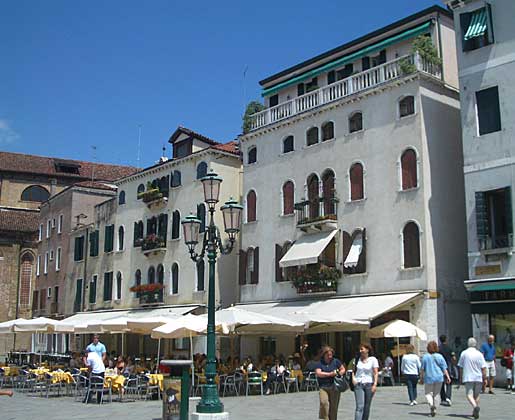Venezia (Venice) - the Ultimate Walkable Urban City!
![]()
Venezia (Venice) is the ultimate walkable urban city! .
The approach to Venezia is a causeway with road and rail ways that terminate in a complex of car parks, bus and rail stations. It is here that you leave motorized street vehicles behind and enter a new place, little changed since the 1400s, where you must either walk into the maze of narrow streets or catch a vaporetto (bus boat), a water taxi, or a gondola to travel by water.



Rolling our wheely bags behind, we chose to walk, We soon realized that walking was a bit more difficult than anticipated since the streets frequently cross canals via step bridges - 4 or 5 steps up, followed by 4 or 5 more back down. Still, we immediately appreciated the total lack of motorized vehicles on the streets! The only motorized traffic is on the canals. There was plenty of congestion - in many places walkers filled the narrow streets.


The Centro Storico (Historic Center) of Venezia includes the "attractions" that tourists come to see. The main focus is the Piazza San Marco, a grand expanse of gray and white marble paving in a herringbone pattern surrounded by the colonnaded buildings that provide a grand elegance to the Piazza.

The imposing Basilica with its five domes and facade encrusted with statues and mosaics stands at one end (top left). The Campanile (bell tower) rises nearby (top right). To the left is the Torre Orologio, the clock tower (bottom left). To the right of the Basilica is the elegant Palazzo Ducale, a broad facade of white and peach stones in a checked pattern surmounted by the lion of San Marco surveying his realm (bottom right).




This amazing confluence of urban elegance stands adjacent to the Canale Grande where gondolas and vaporettos glide by.


A short vaporetto ride away is Rialto Bridge with its classic curve and colonnade. Our hotel was nearby.

Along the Canale Grande are more architectural gems, the whole offering such a pleasing scene one could believe in time travel back to 1450 except that the people were wearing modern clothes, talking on mobile phones and snapping photos with digital cameras!


To understand Venezia's urban life, we spent five days exploring this unique place. We walked through narrow streets, some residential with appealing wood doors and flowers in the windows, and some with shops on the ground floor and apartments above. We scaled the step bridges over canals regularly and sometimes found the street ended at the Canale Grande or opened onto a campo (plaza) with a grand chiesa (church) on one side and kiosks and shops along the others. Whenever we were thirsty or hungry, a cafe or pizzeria was always nearby and happy to serve us.


We quickly learned that the 2008 Euro Cup tournament was going on, so we spent several evenings sitting outside a small bar with many new friends watching the game on the two TVs set up in its windows.

One day, we traveled by vaporetto to the island of Murano where the famous glass makers live and work. Everything imaginable made of glass in every color filled the shop windows, and even some of the parks. Seeking the 'real' Murano, we ducked down a small alley that opened into a neighborhood of lowrise apartments with neat gardens. Another turn left us in a small square with cafes.




Another day, we rode the vaporetto to the Giardini, Venezia's green space on the east end of the city. We walked along paths shaded by large trees, found a shady bench, and sat to watch people (below left). A stop at a small food store provided a picnic lunch which we ate sitting on another shady bench in a smaller park surrounded by apartments and shops (below right).


It is astounding to contemplate what it takes to provision the food, drink, and all the other stuff needed by both residents and visitors, as well as removing the solid waste they create, considering that it must all be done by boat. We did not really discover how this all occurs but we observed a few elements: 'work' boats equipped with cranes to haul cartons of goods and move them onto the docks; hand carts to move the goods to destinations on land; small dumpsters that can be pushed to docks and lifted by cranes to be emptied into bins on boats; hand carts designed to be wheeled over the step bridges.


Life in Venezia probably had an intensity that might become wearing over time. In fact, those financially successful residents of the 1700s bought property in the countryside of the mainland along the Brento canal and had villas built. These grand country houses offered a calm and quiet respite from the business and bustle of the city. A few still remain, now open to visitors, and we traveled by bus to the village of Malcontenta to visit Villa Widman Foscaria. It reminded us of the plantation homes of the American south with its grand halls, frescoed walls, chandeliers. Outside we walked through the garden shaded by old trees and inhabited by peacocks. We contemplated the wealth that enabled the Venezian merchants to build these imposing houses to spend the week ends or the occasional week.


Ending our visit, we boarded a vaporetto to take us to the station and the waiting train that would take us back to the mainland and the 21st century, now with a greater understanding of the urban life of that earlier age, thankfully still preserved in Venezia.
Click here to return to our More Adventures in Europe - Summer 2008 page
![]()